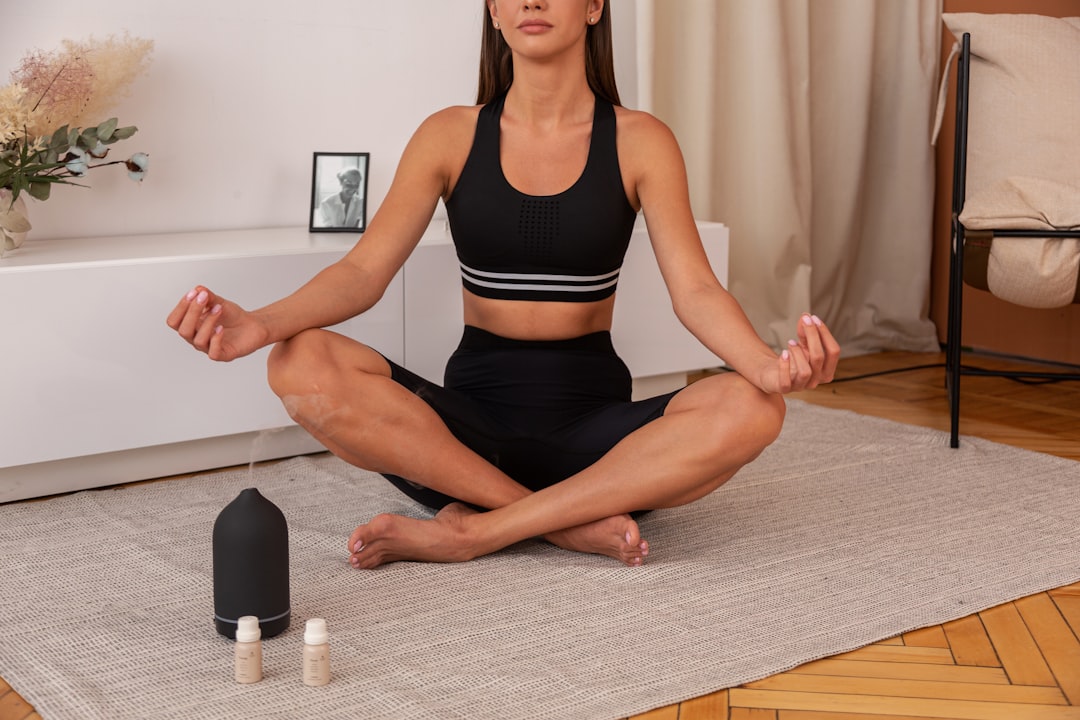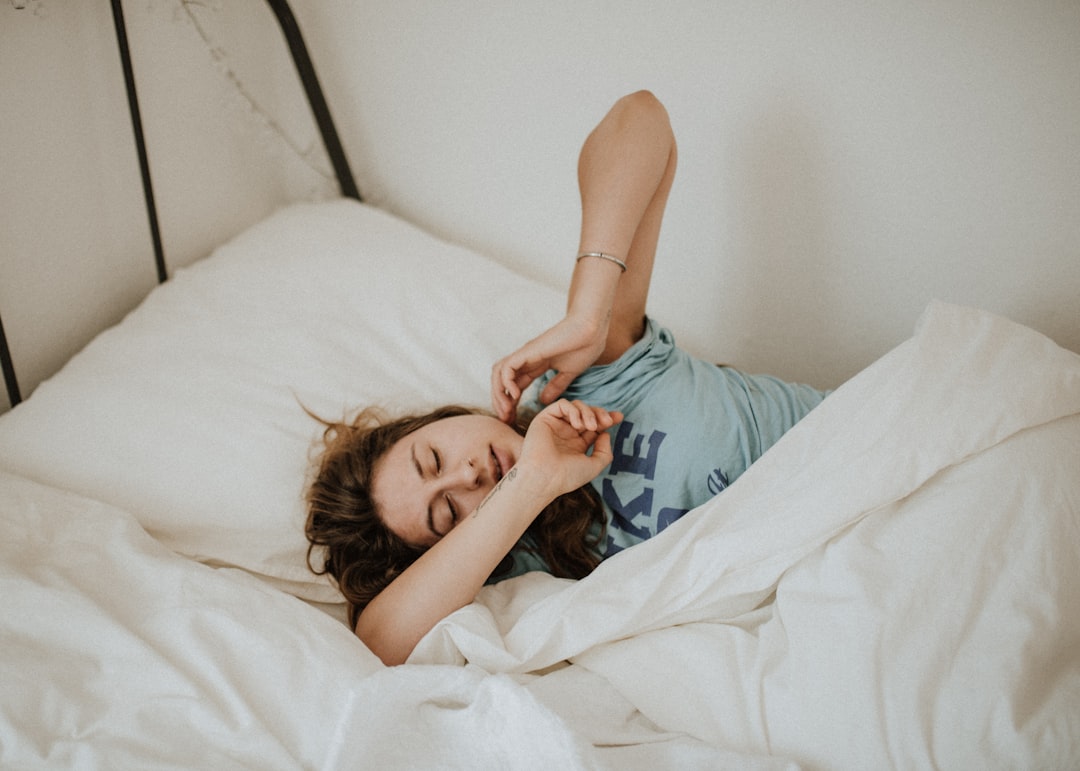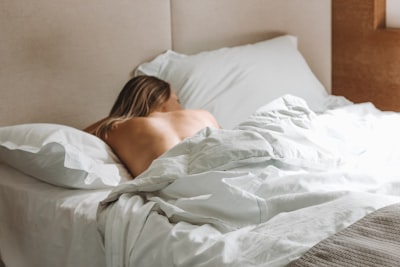Fall Asleep Fast: 13 Breathing Exercises for Deep Sleep
Stop tossing and turning at night. Enjoy deep sleep by trying these breathing exercises known to relax the body and calm the mind.
If you find yourself stressed and unable to fall asleep, consider taking a few minutes to practice some deep breathing exercises. Breathing is one of the most effective ways of controlling your body’s reaction to stress. Your heart rate slows and your breath becomes more steady. A calmer mind helps you relax into sleep so that when morning comes, you are well-rested and ready for the day ahead.
In this article, we'll share our top 13 breathing exercises for sleep.
1. Belly Breathing
Abdominal breathing is a special type of slow deep breathing which increases oxygen intake, especially when people are stressed. To practice abdominal breathing, lie on your back with a pillow under your knees and another behind your head. Place one hand on your lower rib cage and one hand at the center of your waistline (just above where vestigial tail bones might be). Breathe slowly and fully through both nose and mouth for about five minutes while focusing entirely on using the diaphragm muscle to pull air into your lungs by expanding it inwardly rather than up or out as most people do when they breathe.
2. The 4-7-8 Breathing Method
The 4-7-8 breathing method is a relaxation technique that involves breath control. It is very helpful to reduce anxiety and fear, as well as any tension of the body.
To do this breathing method, you will need to:
- Inhale for four seconds
- Hold your breath for seven seconds
- Exhale for eight seconds.
- Repeat until relaxed
It is a calming method that you can incorporate into your day to day life to help reduce anxiety or help you get to sleep. We like this demo by Well With Hels.
3. Diaphragmatic Breathing
Diaphragmatic breathing, also called belly breathing, is a type of deep breathing that is good for relaxation. To do diaphragmatic breathing, place one hand on your stomach and the other on your chest. Breathe in slowly through your nose, letting your stomach expand. Exhale slowly through your mouth. Take deep breaths, allowing your diaphragm to move up and down. Slow your breathing and focus on the rise and fall of your stomach.
4. Three-part Breathing Exercise
This one is a great way to improve your overall breathing. The exercise involves inhaling deeply, exhaling fully, and then repeating the cycle. It can help to improve your lung capacity and also help to prevent shortness of breath.
Try this:
-
Inhale deeply and slowly.
-
Exhale completely while paying close attention to your body and how it feels.
-
When you feel ready, slow down your exhale until it's twice as long as your inhale after a few repetitions.
Check out JenYoga:
5. Body Scan
The body scan is a meditative practice that involves slowly and carefully moving your attention through your entire body, looking for areas of tension. Once you've identified the tense spots, focus on releasing them with each exhale. Start by spending one minute focusing on breathing in and out from any part of your body—your toes or fingers, for example. Then move to another area and repeat the process until you've covered all parts of your torso and limbs (up to the top of your head).
- If it helps, start at an easy spot such as behind your knees or below your shoulders, where there may be less mental chatter about what needs to get done later or how badly you slept last night. You can also begin at specific trigger points like "My neck is tight," or "I'm holding my breath."
- Tune into your feelings, pay extra attention to all the sensations you may feel in the body, and imagine each breath flowing from the sole of your foot.
When you practice the body scan, you are training yourself to focus on your breathing. In addition, if you practice regularly, you will notice a shift in how tense your muscles feel in response to stress or anxiety.
6. Counting While Breathing
One way to relax and fall asleep is by using a mental trick called "counting while breathing." This might sound like an odd technique, but it's been used effectively for hundreds of years to achieve calmness.
The next time you have trouble falling asleep, try this:
• Breathe in slowly through your nose and count silently as you do so (1-2-3…).
• Pause briefly after each number on the inhalation.
• Breathe out through your mouth again as you count backward from 6 to 1 (5-4-3…).
7. Visualization to Release Energy
Visualization is a way of creating mental images and sensations in your mind, with the goal of getting rid of negative energy or bringing positive energy into your life. It encourages calm breathing before sleep. The practice is not difficult to perform, but it does require some dedication to do it regularly.
- Start by finding a quiet place where you will be undisturbed for 10 minutes.
- You can begin anytime during the day whenever you feel stressed or anxious.
- Close your eyes, breathe deeply and relax as much as possible while sitting comfortably in a chair with both feet on the floor.
- Imagine that there is a ball of white light right above your head and another one below your feet like two equal size balls connected by an invisible line between them.
- Now imagine that one ball contains all of your negative energy – anxiety, fear, stress … Inhale slowly through this part and exhale through the other side when imagining that this ball starts shrinking more and more until disappears completely from sight like air going out from inside an empty balloon.
- Then imagine that the other ball is filled with pure positive energy – love, happiness, peace …. Inhale again through this side and exhale through the other side when imagining that this ball starts growing more and more until it fills the whole room.
- Try to maintain your focus on these two balls for as long as you can without feeling fatigued or discomfort in your body.
Repeat this exercise at least 3 times a week until you feel more relaxed.
8. Alternate Nasal Breathing Exercise
A simple breathing exercise can help you relax and reduce stress. Alternate nostril breathing is a yoga-based relaxation technique that helps to clear your mind, calm your body and balance your energy levels.
The practice, which involves the rhythmic switching between left and right nostrils in an alternating pattern, was developed many centuries ago for meditation purposes. It's also used as part of other practices such as pranayama or kriya.
In recent years it has also been used by Westerners who want to learn how to meditate but are unsure how to begin. A 2013 study published in the Journal of Alternative and Complementary Medicine found that people who tried nasal breathing exercises felt less stressed afterward than before they did them; those who didn't do anything differently reported no improvement at all.
9. Box Breathing
If you’ve ever watched an Olympic diver or gymnast, you may have noticed that they take a series of deep breaths before beginning their performance. Box breathing, also known as square breathing, is a type of diaphragmatic breathing that uses the same method athletes use to relax and focus on what lies ahead.
Breathe in for four seconds through your nose; hold your breath for four seconds; exhale slowly through your mouth for four seconds; then breathe normally until it’s time to start again. It helps if you think about each part of the process while doing box breathing: inhaling air into your lungs, holding onto the air inside (and thinking calmness), pushing out the air, then holding and repeating the cycle.
After practice with these techniques over several days or weeks, people report less anxiety and better responses in high-pressure situations—from job interviews to test-taking—according to researchers.
10. Breathe Out Positive Energy
This breathing exercise can help you relieve stress and get through difficult times. It’s a simple technique called “breathing in and letting go” or “breathing in and releasing,” which uses slow, long breaths to clear your mind of negative thoughts and feelings.
To do this exercise:
- Sit comfortably with both feet on the floor, hands resting on your thighs or crossed over each other in front of you.
- Take several slow, deep breaths through your nose while visualizing a blue light flowing into every part of your body from head to toe (or wherever you feel most stressed)
- You should feel relaxed after each breath; if not, repeat the exercise until you do.
11. Progressive Muscle Relaxation
Progressive muscle relaxation is a technique in which you tense and relax different muscles, one by one. Start with your toes and move up to your head, tensing the targeted muscle intensely for five seconds before releasing it completely. Once relaxed, repeat a soothing phrase or word of choice (or use this phrase) while concentrating on the sensation of peace and calm that comes from being fully relaxed.
Follow these steps:
Tense: Slowly clench your right hand into a fist as hard as possible without causing pain; hold for five seconds
Relax: Open your hand wide; hold for five seconds
Tense: Tighten every muscle in your face—including eyebrows, cheeks, jaw line and mouth—as tight as you can; hold for five seconds
Relax: Allow all facial muscles to return to normal; hold for ten seconds
Tense: Squeeze each shoulder blade toward the spine until they touch; hold for three counts.
Relax: Let shoulders drop back down away from the spine, then repeat the process if necessary until you feel relaxed.
12. Breathing Imagery
One of the easiest ways to relax is by using breathing imagery. Imagery involves using your thoughts and imagination to create mental images that assist you in achieving a goal, whether it's relaxation or something else entirely. It can be difficult to sleep if you have things on your mind. One way to manage this problem is by imagining yourself at rest while focusing on different parts of your body as they become relaxed.
13. Buteyko Breathing
Buteyko breathing is a type of breath control that is said to improve overall respiratory function. The goal is to reduce the amount of air that is taken in with each breath and to normalize the breathing pattern. This type of breathing is named after Konstantin Buteyko, who developed the technique in the 1950s. It is is said to reduce the effects of stress and anxiety. It is also claimed to improve lung function, which can help with diseases such as asthma, COPD and bronchitis.
Here's How to Do it in 6 Steps:
The process is easy, and you can practice the technique in only a few moments. Get comfortable and take a few stress-free breaths, and we will start:
-
Inhale through the nose.
-
Exhale normally through the nose.
-
Inhale for two seconds through the nose.
-
Exhale slowly through the nose for five seconds.
-
Pause and hold your breath for five seconds.
-
Repeat the previous steps 10 times.
Take a look at how it’s done by Buteyko Clinic International
What Else Can Help
Exercise for a Better Night's Sleep
Most people know that exercise is good for you, but might not be aware of all the ways it benefits your body. Exercise has been shown to help improve sleep quality, including deep sleep. In fact, people who engage in at least 30 minutes of moderate aerobic exercise daily have been shown to enjoy improved sleep quality and duration.
Sleeping Positions that Improve Your Breathing
When it comes to getting a good night's sleep, the position you choose to sleep in is important. Different sleeping positions can help you breathe better and get more restful sleep.
The best sleeping position for deep breathing is on your back with your head elevated and your knees bent. This position keeps your airways open and allows you to breathe deeply. It also helps to keep your spine aligned, which can reduce pain in the morning.
You can also sleep on your side with a pillow between your legs and your head elevated. This position helps keep the airways open, making it easier to breathe deeply. However, it is important to note that this position can cause neck and back pain if used for too long.
Summary
A variety of breathing techniques can help you drift off to sleep naturally. Some will help you relax and sleep, while others can help you breathe better. Belly breathing and the 4-7-8 method are great ways to relieve stress and aid sleep. Counting while breathing can help you relax, reduce anxiety, and is also a powerful tool for more restful sleep. Alternate nostril breathing is an ancient yoga technique that has been used effectively for centuries. It helps to clear your mind, calm your body and balance your energy levels. If a person simply chooses the type that works best for them, they will fall asleep before they know it.
There are many benefits to trying out these exercises. Some people find that they help them relax and sleep better, while others find that they help them breathe better. Belly breathing is a great way to get deep into the lungs and improve your overall respiratory health.
Did you know adding certain fruits into your diet may also help your catch better Zzz’s? Learn more here.
References:
“Exercising for Better Sleep.” Johns Hopkins Medicine, 8 Aug. 2021, https://www.hopkinsmedicine.org/health/wellness-and-prevention/exercising-for-better-sleep.
Ma, Xiao, et al. “The Effect of Diaphragmatic Breathing on Attention, Negative Affect and Stress in Healthy Adults.” Frontiers in Psychology, vol. 8, Jan. 2017, doi:10.3389/fpsyg.2017.00874.
Get your daily dose of wellness delivered straight to your inbox. Sign up now for our newsletter.
Disclaimer:
These statements have not been evaluated by the Food and Drug Administration. This product is not intended to diagnose, treat, cure, or prevent any disease.
The content is purely informative and educational and should not be construed as medical advice. Any opinion expressed should not be treated as a substitute for professional medical advice. By using this website, you accept our Terms & Conditions and Privacy Policy. We cannot guarantee the accuracy of the information presented at this site. This article is not intended to be used as a substitute for the diagnosis and treatment of any health problem or to prescribe any medication or other treatment. You should consult with your health care provider before starting any diet, exercise, or supplementation program, before taking any medication, or if you have or suspect you might have a health problem.







